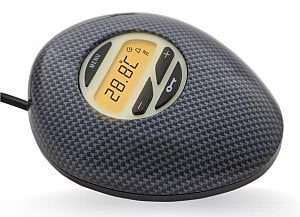Carbon Waterbed Heaters
240 watt for all Soft-Sided Waterbeds, Single and Dual Bladder
320 watt for all Hard-Sided Waterbeds, Can be used in Queen and King Soft-Sided beds
The Carbon Classic Heater Control.
Adjustable temperature scale 25º-35ºc.
Set and Forget, Suited to those that make few temperature adjustments through out the year.
All Carbon Heaters come with a 2 Year Warranty
The Carbon IQ LCD Digital Control.
Temperature Range 24º-36ºc. Accurate to .1of a degree. Has an on/off timer function. You can set what hours it can send heat to the bed, Great for solar systems that harvest the electricity. Clock and Alarm. Conditioner Reminder Function.
Great for those that require finer tuning of their waterbeds temperature. The IQ defaults to 28c in the event of a power failure.
In areas that have frequent power interruptions. The Classic would be the better choice
Calesco Digital Satellite control.
Temperature range 25º-36ºc. Accurate to 1 degree. 250 watt with a foam-backed pad. Suitable for all Soft-sided waterbeds and all Hard-sided waterbeds up to Queen Size. Has On/Off timer function and a clock. It will default to 28 degrees in the event of a power failure.
2 Year warranty on the Controller and 5 year warranty on the Pad.
Waterbed Heater Usage Guide and Tips.
Most of the year your waterbed heater would be set in the 27-29 degree range. Lower in summer and higher in winter. At 25c The waterbed is considered to be slightly cool to neutral. It takes a change of around 2 degrees to notice. So 27c is a good starting point. For those who prefer a little warmer 29 degrees. A simple test is to lay with bare back directly on the bladder and see how it feels. Or use a food thermometer to take the beds temperature as a reference.
The warmth rating of your bedding influences your sense of how warm or cool the bed feels. eg The heater in winter is turned up almost all the way and the bed feels cold. The issue is with the bedding. It has insufficient insulation to keep the heat in. Using a summer weight doona in winter has the heater being turned up way higher than it needs to be, Wasting electricity. It can also be that and you have an extra thick wool underlay or a layer of foam or gel foam between you and the bladder, This extra insulation requires a lot more power to drive the heat through it. In some instances heaters used for hard sided beds containing over 600 liters of water have needed to be installed in soft sided beds that use only half that amount of water. Wasting $ in electricity.
Another example is when the bed is way to warm even though the thermostat is set very low. The opposite of the above. The bedding has to much insulation for the season it is being used in. And if you have extra insulation between you and the water mattress, Its ability to conduct away the extra temperature is prevented by the extra insulation. This scenario is the cause of premature stress cracks due the the vinyl being harder at the low temperature setting.
I have seen beds with foam and man made materials used for the cover, Running with the heaters turned off, Thoroughly saturated with perspiration. During the repairing of leaks caused by the low temperatures.
Much testing over the years has gone into the selection of the most suitable thickness wool top, A balance of not to thick and not to thin. Thick enough to provide sufficient insulation from the vinyl bladder. The symptom of not enough insulation allows the closeness of the vinyl to generate a lot of heat. Think of a vinyl car seat in summer. a sweaty mess. cover the seat with a towel, Ok for a while. Then fit a wool sheepskin cover. Perfect. One symptom is that after a toilet stop in the wee hours the bed feels like a ice block when you hop back in. The result of the insufficient insulation has caused much perspiration build up. So that when you leave your spot for a few minutes it goes cold.
To allow the waterbed to be truly warm in winter and cool in summer. The wool top needs to be just thick enough to allow the heat conductive properties of water to transfer any excess heat away. To much insulation and it stops it from working.
The all seasons doona is worthy of consideration. They come with 2 doona's in the box. One Light weight and the other a Medium Weight. They then can be joined together to form a Heavier weight doona for the depths of winter.
Having your waterbed a bit to warm can result in restless sleep, As your body tosses and turns trying to cool itself.
One question I always ask my self when salespeople go on about the exclusiveness of their claimed better product. Is it better for them with more sales hype? Or better for customers. I figure that if it is a genuine improvement in design, Many more would copying the feature. In businesses today you only get a 6-month gap, Before everyone else implements the same design feature if they believe it worthy. If no one else is doing it. Ask someone that will give you a list of the pros and cons and you choose what suits you best.
I always say, When Your waterbed is at its best you get 8 hours worth of sleep in 6.5, Why? Because a properly designed waterbed, set up and adjusted correctly provides deeper relaxation and more Rem sleep.
Questions or Advice Call Lyle 03-9795-5964.
?

